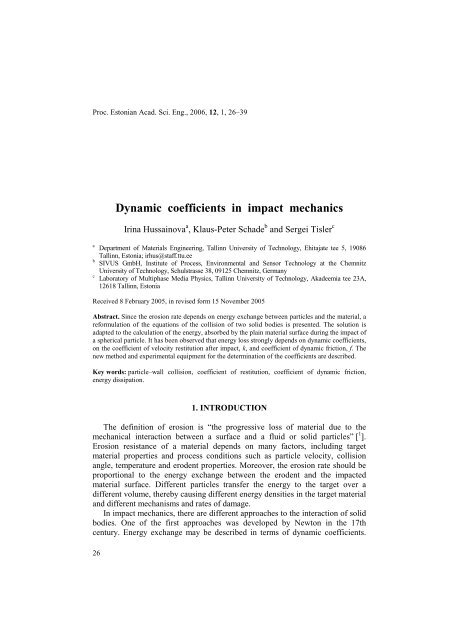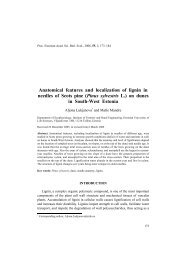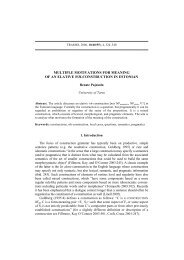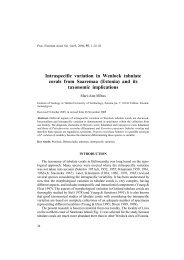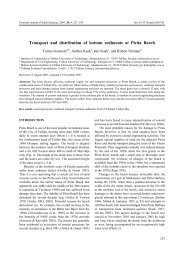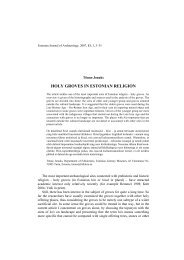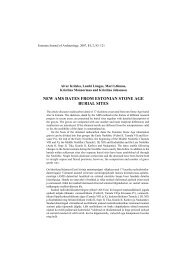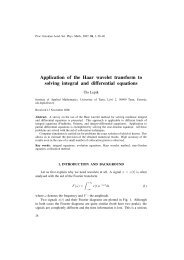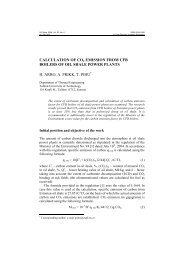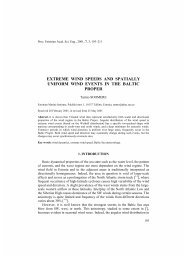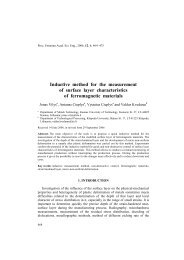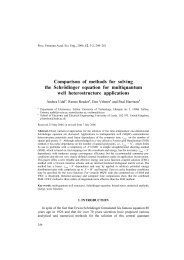Dynamic coefficients in impact mechanics
Dynamic coefficients in impact mechanics
Dynamic coefficients in impact mechanics
You also want an ePaper? Increase the reach of your titles
YUMPU automatically turns print PDFs into web optimized ePapers that Google loves.
Proc. Estonian Acad. Sci. Eng., 2006, 12, 1, 26–39<br />
a<br />
b<br />
c<br />
<strong>Dynamic</strong> <strong>coefficients</strong> <strong>in</strong> <strong>impact</strong> <strong>mechanics</strong><br />
Ir<strong>in</strong>a Hussa<strong>in</strong>ova a , Klaus-Peter Schade b and Sergei Tisler c<br />
Department of Materials Eng<strong>in</strong>eer<strong>in</strong>g, Tall<strong>in</strong>n University of Technology, Ehitajate tee 5, 19086<br />
Tall<strong>in</strong>n, Estonia; irhus@staff.ttu.ee<br />
SIVUS GmbH, Institute of Process, Environmental and Sensor Technology at the Chemnitz<br />
University of Technology, Schulstrasse 38, 09125 Chemnitz, Germany<br />
Laboratory of Multiphase Media Physics, Tall<strong>in</strong>n University of Technology, Akadeemia tee 23A,<br />
12618 Tall<strong>in</strong>n, Estonia<br />
Received 8 February 2005, <strong>in</strong> revised form 15 November 2005<br />
Abstract. S<strong>in</strong>ce the erosion rate depends on energy exchange between particles and the material, a<br />
reformulation of the equations of the collision of two solid bodies is presented. The solution is<br />
adapted to the calculation of the energy, absorbed by the pla<strong>in</strong> material surface dur<strong>in</strong>g the <strong>impact</strong> of<br />
a spherical particle. It has been observed that energy loss strongly depends on dynamic <strong>coefficients</strong>,<br />
on the coefficient of velocity restitution after <strong>impact</strong>, k, and coefficient of dynamic friction, f. The<br />
new method and experimental equipment for the determ<strong>in</strong>ation of the <strong>coefficients</strong> are described.<br />
Key words: particle–wall collision, coefficient of restitution, coefficient of dynamic friction,<br />
energy dissipation.<br />
26<br />
1. INTRODUCTION<br />
The def<strong>in</strong>ition of erosion is “the progressive loss of material due to the<br />
mechanical <strong>in</strong>teraction between a surface and a fluid or solid particles” [ 1 ].<br />
Erosion resistance of a material depends on many factors, <strong>in</strong>clud<strong>in</strong>g target<br />
material properties and process conditions such as particle velocity, collision<br />
angle, temperature and erodent properties. Moreover, the erosion rate should be<br />
proportional to the energy exchange between the erodent and the <strong>impact</strong>ed<br />
material surface. Different particles transfer the energy to the target over a<br />
different volume, thereby caus<strong>in</strong>g different energy densities <strong>in</strong> the target material<br />
and different mechanisms and rates of damage.<br />
In <strong>impact</strong> <strong>mechanics</strong>, there are different approaches to the <strong>in</strong>teraction of solid<br />
bodies. One of the first approaches was developed by Newton <strong>in</strong> the 17th<br />
century. Energy exchange may be described <strong>in</strong> terms of dynamic <strong>coefficients</strong>.
Classical theory of <strong>impact</strong>, based on the Newton’s second law, cont<strong>in</strong>ues to be<br />
successfully used to model the process of two-body collision. The equations<br />
<strong>in</strong>volve <strong>coefficients</strong> of velocity restitution after the collision, impulses and<br />
momentum. Further, approaches consider<strong>in</strong>g frictional forces were developed. A<br />
comprehensive review of the collision models has been presented <strong>in</strong> [ 1 ].<br />
Depend<strong>in</strong>g on the contact process and the approach, solution of the model<br />
equations can <strong>in</strong>volve mathematical methods rang<strong>in</strong>g from l<strong>in</strong>ear algebraic to<br />
nonl<strong>in</strong>ear differential equations. The objectives of this paper are the proper use,<br />
<strong>in</strong>terpretation and measurement of the dynamic <strong>coefficients</strong> <strong>in</strong> the case of solid<br />
particle contacts with a flat solid surface.<br />
S<strong>in</strong>ce the energy exchange is related to velocity and to the angle of <strong>impact</strong>,<br />
these <strong>coefficients</strong> are to be determ<strong>in</strong>ed with a great care. As dynamic <strong>coefficients</strong><br />
are not material constants, the <strong>coefficients</strong> must be evaluated experimentally or<br />
analytically related to the contact process. Any change <strong>in</strong> energy loss due to<br />
material effects can easily be masked by a small change <strong>in</strong> velocity. To clarify<br />
the details of the two-body <strong>in</strong>teraction, a special test facility, equipped with a<br />
digital video camera, was worked out and used.<br />
2. IMPACT MECHANICS WITH APPLICATION TO ENERGY LOSS<br />
The problem to be approached is that of a solid particle <strong>impact</strong><strong>in</strong>g a massive<br />
flat surface. Figure 1 shows a diagram of the particle–wall collision. The axes t<br />
and n are chosen tangential and normal to the plane surface of the specimen,<br />
respectively.<br />
d c<br />
n<br />
C<br />
l<br />
β<br />
d n<br />
t<br />
O<br />
F t<br />
F n<br />
Fig. 1. Diagram of the two-body <strong>in</strong>teraction.<br />
27
The appropriate equations are well known [ 2 ] and their mathematical evaluation<br />
and <strong>in</strong>terpretation are given <strong>in</strong> detail elsewhere [ 2–4 ]. In our case, the<br />
equations can be written as follows [ 2 ]:<br />
+ =− + (1)<br />
v d k( v d ),<br />
n c n Ω<br />
ω c<br />
2 1<br />
− = − (2)<br />
fv v fv v<br />
n t n t<br />
2 2 1 1 ,<br />
− − = − − (3)<br />
md v md v I md v md v I ,<br />
c n n t c n n Ω<br />
t<br />
2 2 1 1<br />
where v n 1<br />
and v t 1<br />
are the normal and tangential components of the particle<br />
velocity before collision, respectively, v n 2<br />
and v t 2<br />
are the normal and tangential<br />
components of the particle velocity after collision, describ<strong>in</strong>g the movement of<br />
the centre of the mass Ω C ω , and are the f<strong>in</strong>al and <strong>in</strong>itial angular velocities,<br />
respectively, and I is the moment of <strong>in</strong>ertia. Equation (1) conta<strong>in</strong>s a coefficient<br />
k that expresses the process of the normal velocity restitution of particles at the<br />
po<strong>in</strong>t O . It is obvious that the value of k is between 0 and 1. The coefficient f<br />
<strong>in</strong> Eq. (2) represents the process of tangential velocity restitution and is named<br />
the coefficient of dynamic friction. F<strong>in</strong>ally, Eq. (3) expresses the conservation of<br />
the angular momentum about the po<strong>in</strong>t O .<br />
The assumption of sphericity of the solid particle simplifies the equations to a<br />
great extent, and <strong>in</strong> the case of a ball the equations can be rewritten as [ 2 ]<br />
v<br />
kv ,<br />
2 n1 n<br />
=− (4)<br />
ω<br />
− =− + (5)<br />
v v f(1 k) v ,<br />
Ω<br />
where R is the particle radius and<br />
solid sphere<br />
t t n<br />
2 1 1<br />
f(1 k)<br />
+ v n<br />
λ<br />
− =<br />
1<br />
,<br />
(6)<br />
ω<br />
R<br />
2 2<br />
λ ϕ = (ϕ R is the radius of gyration); for a<br />
λ = 52.<br />
Generally, these equations correspond to the case when a slid<strong>in</strong>g movement of<br />
the sphere takes place. When slid<strong>in</strong>g f<strong>in</strong>ishes, the particle will either stop or roll.<br />
A discussion of the conditions under which slid<strong>in</strong>g ceases, allow<strong>in</strong>g an<br />
adhesion to take place, has been presented <strong>in</strong> [ 2 ]. However, it is worth mention<strong>in</strong>g<br />
that the dynamic friction coefficient is small enough and that prevents occurrence<br />
of the adhesion processes between the particle and the target material. Accord<strong>in</strong>g<br />
to [ 2,5 ], the boundary condition for slid<strong>in</strong>g is as follows:<br />
f<br />
2 ( vt<br />
R ) ω −<br />
1<br />
≤<br />
.<br />
+ 7(1 k)<br />
v<br />
n1<br />
(7)<br />
28
For non-slid<strong>in</strong>g conditions a general solution corresponds to the roll<strong>in</strong>g of<br />
particles and the equations should be replaced by [ 2 ]<br />
v<br />
=− kv<br />
(8)<br />
n ,<br />
2 n1 − =− + (9)<br />
2 (<br />
7 ),<br />
vt v<br />
2 t<br />
v Rω<br />
1 t1<br />
− =− − (10)<br />
51 ( vt<br />
7 R<br />
R ).<br />
Ω ω ω<br />
1<br />
The loss of the k<strong>in</strong>etic energy K is expressed as:<br />
ω<br />
= + + − + − (11)<br />
K<br />
1<br />
m( v v )<br />
1<br />
I<br />
1<br />
m( v v )<br />
1<br />
I .<br />
Ω<br />
2 2 2 2 2 2<br />
n t n t<br />
1 1 2 2<br />
2 2 2 2<br />
Equation (11) can be rewritten <strong>in</strong> terms of Eqs. (4), (5) and (6):<br />
= + − + − + + (12)<br />
1 2 2<br />
(1 )[1 2 (1<br />
2<br />
)(1 )],<br />
K mvn<br />
k k fb f λ k<br />
1<br />
where b ( vt<br />
R ) v ω = − .<br />
1 n1<br />
The energy loss can be expressed <strong>in</strong> a more convenient, non-dimensional form<br />
by divid<strong>in</strong>g K by the <strong>in</strong>itial k<strong>in</strong>etic energy of a particle. This normalized energy<br />
K is expressed as<br />
∗<br />
K<br />
2 2<br />
1 k b 1 f −<br />
f<br />
= + − ⎜2 ⎟,<br />
1 b λ<br />
+ + ⎝ ⎠<br />
1 b 1 fc fc<br />
∗<br />
⎛ ⎞<br />
2 2<br />
(13)<br />
+<br />
where f<br />
c<br />
is the maximal value of the coefficient of dynamic friction:<br />
f<br />
c<br />
1 b<br />
= .<br />
(14)<br />
λ 1 + 1 + k<br />
Equation (14) approaches the expression (7) <strong>in</strong> the case of a solid sphere.<br />
For some applications, the <strong>coefficients</strong> may be determ<strong>in</strong>ed with an analytical<br />
procedure like the dynamic f<strong>in</strong>ite element analysis, or experimentally. Therefore<br />
the ma<strong>in</strong> task of this study is experimental determ<strong>in</strong>ation of the <strong>coefficients</strong> of<br />
restitution to calculate the particle energy loss or the energy, absorbed by the<br />
target material dur<strong>in</strong>g the <strong>impact</strong>.<br />
3. EXPERIMENTAL PROCEDURE AND MATERIALS<br />
A schema of the test equipment used for the measurements of particle<br />
velocities and <strong>impact</strong> angles is shown <strong>in</strong> Fig. 2. An Ar-Ion laser beam was used<br />
29
to illum<strong>in</strong>ate the work<strong>in</strong>g area [ 5,6 ]. The light area was produced by widen<strong>in</strong>g the<br />
laser beam with a cyl<strong>in</strong>drical lens. The <strong>impact</strong> event was recorded with a digital<br />
video camera and transferred <strong>in</strong>to a PC. The video images were then decomposed<br />
<strong>in</strong>to <strong>in</strong>dividual frames with software. A calibration procedure was carried out to<br />
elim<strong>in</strong>ate any distortions.<br />
Figure 2 shows the particle accelerator, which was specially developed by<br />
SIVUS GmbH at Chemnitz University of Technology, Germany, for the<br />
determ<strong>in</strong>ation of dynamic <strong>coefficients</strong>. The particles leave the feed<strong>in</strong>g system<br />
and enter the particle accelerator (a rotat<strong>in</strong>g disk). This accelerator permits a<br />
precise evaluation of the collision variables. A centrifugal force drives particles<br />
through the channels of the accelerat<strong>in</strong>g disk that is set <strong>in</strong> rotation by a<br />
circulat<strong>in</strong>g belt [ 5,7 ]. Be<strong>in</strong>g pushed by the centrifugal force, the particles move<br />
towards a target that can be fixed at a correspond<strong>in</strong>g angle onto a bracket of the<br />
cover. Therefore the particles outlet has a fixed spatial position and a negligible<br />
rotation.<br />
Steel and ceramic–metal composites (cermets) of different composition were<br />
used as target materials. Composition of the tested materials and hardness ratio of<br />
the material and glass particles (HV = 540) are listed <strong>in</strong> Table 1.<br />
Fig. 2. Experimental facility.<br />
Table 1. Composition and mechanical properties of materials tested<br />
Grade Composition Vickers<br />
hardness, HV10<br />
Hardness ratio,<br />
HV /HV<br />
C20 80wt % Cr 3 C 2 + 20wt %Ni 1140 2.11<br />
W15 85wt % WC + 15wt %Co 1258 2.33<br />
C20S 80wt % Cr 3 C 2 + 20wt %Ni (reaction s<strong>in</strong>ter<strong>in</strong>g) 1233 2.28<br />
St 16MnCr5 steel 740 1.37<br />
m<br />
p<br />
30
Number of events<br />
120<br />
100<br />
80<br />
60<br />
40<br />
20<br />
0<br />
<strong>impact</strong><br />
velocity<br />
rebound<br />
velocity<br />
4 5 6 7 8 9 10<br />
Particle velocity, m/s<br />
Number of events<br />
600<br />
500<br />
400<br />
300<br />
200<br />
100<br />
0<br />
<strong>impact</strong><br />
velocity<br />
rebound<br />
velocity<br />
15 20 25 30 35<br />
Particle velocity, m/s<br />
(a)<br />
(b)<br />
Fig. 3. Distribution of <strong>in</strong>itial and rebound particle velocities: (a) grade C20 as the target and <strong>impact</strong><br />
angle of 75°; (b) grade W15 as the target and <strong>impact</strong> angle of 30°.<br />
(a)<br />
(b)<br />
Fig. 4. Particle tracks obta<strong>in</strong>ed with the video camera: (a) <strong>impact</strong> angle 30°; (b) <strong>impact</strong> angle 60°.<br />
The particle velocity before <strong>impact</strong> was 10 and 30 m/s and the collision angle<br />
was from 15 to 85°. The 125-µm glass beads were used as the <strong>impact</strong><strong>in</strong>g<br />
particles. A characteristic distribution of the bead velocity is illustrated <strong>in</strong> Fig. 3.<br />
Because of some deviation from the <strong>in</strong>itial velocity, mean velocity is shown. A<br />
view of particle tracks is shown <strong>in</strong> Fig. 4.<br />
Results of a study of the steel target – glass ball <strong>in</strong>teraction are described <strong>in</strong> [ 7,8 ].<br />
4. RESULTS AND DISCUSSION<br />
The boundary conditions for the slid<strong>in</strong>g <strong>impact</strong> can be rewritten us<strong>in</strong>g Eq. (7)<br />
with ω = 0 as follows:<br />
f c<br />
≤<br />
2 1 1<br />
71 k tan<br />
α<br />
1<br />
,<br />
(15)<br />
+<br />
31
where α<br />
1<br />
is the <strong>impact</strong> angle. The <strong>coefficients</strong> of the velocity restitution k and<br />
of the dynamic friction f can be calculated as<br />
| vn<br />
|<br />
2<br />
k = ,<br />
(16)<br />
| v |<br />
n<br />
1<br />
f<br />
| v v − |<br />
t<br />
= (17)<br />
+<br />
2 1<br />
.<br />
(1 k) | v |<br />
t<br />
n<br />
1<br />
The experimental data about the variation of the <strong>coefficients</strong> with the <strong>impact</strong><br />
velocity and angle are presented <strong>in</strong> Figs. 5, 6 and 7. For composite materials the<br />
coefficient of restitution decreases slightly when the <strong>impact</strong> angle <strong>in</strong>creases.<br />
Much lower rebound effect is observed when a more plastic material (steel) is<br />
0.935<br />
Restitution coefficient<br />
0.930<br />
0.925<br />
0.920<br />
0.915<br />
0.910<br />
0.905<br />
0.900<br />
0.895<br />
0.890<br />
W15<br />
C20S<br />
C20<br />
0.885<br />
0.880<br />
20 30 40 50 60 70 80 90<br />
Impact angle, deg<br />
(a)<br />
0.750<br />
Restitution coefficient<br />
0.700<br />
0.650<br />
0.600<br />
0.550<br />
0.500<br />
0.450<br />
0 10 20 30 40 50 60 70 80 90<br />
Impact angle, deg<br />
(b)<br />
Fig. 5. Coefficient of velocity restitution vs <strong>impact</strong> angle: (a) cermets; (b) steel.<br />
32
tested (Fig. 5b). An <strong>in</strong>terest<strong>in</strong>g effect can be noticed when the dependence of k<br />
on the <strong>in</strong>itial <strong>impact</strong> velocity of the particle is studied (Fig. 6). It should be<br />
mentioned that similar effect of <strong>in</strong>itial <strong>in</strong>crease of k has been observed when<br />
composite targets were <strong>impact</strong>ed with glass beads of much larger size of 650 µm<br />
<strong>in</strong> diameter (Fig. 6b). Some <strong>in</strong>crease <strong>in</strong> the coefficient of restitution can be<br />
expla<strong>in</strong>ed by the compression of the target material. Impact<strong>in</strong>g particle squeezes<br />
out the plastic b<strong>in</strong>der and plunges hard carbide gra<strong>in</strong>s <strong>in</strong>to a soft substratum<br />
without any failure. Carbide gra<strong>in</strong>s loose their protective b<strong>in</strong>der, form<strong>in</strong>g a th<strong>in</strong><br />
subsurface transition layer with strength parameters differ<strong>in</strong>g from the bulk body<br />
0.940<br />
0.930<br />
Restitution coefficient<br />
0.920<br />
0.910<br />
0.900<br />
0.890<br />
0.880<br />
0.870<br />
0.860<br />
W15<br />
C20<br />
C20S<br />
0.850<br />
5 10 15 20 25 30<br />
Particle velocity, m/s<br />
(a)<br />
0.98<br />
Restitution coefficient<br />
0.96<br />
0.94<br />
0.92<br />
0.90<br />
0.88<br />
W15<br />
TiC-40% steel<br />
TiC-40% Ni<br />
0.86<br />
5 15 25 35 45 55<br />
Particle velocity, m/s<br />
(b)<br />
Fig. 6. Coefficient of velocity restitution vs particle velocity: (a) present study; (b) [ 7 ].<br />
33
0.140<br />
Coefficient of dynamic friction<br />
0.130<br />
0.120<br />
0.110<br />
0.100<br />
0.090<br />
W15<br />
C20<br />
C20<br />
0.080<br />
5 10 15 20 25 30<br />
Initial velocity, m/s<br />
(a)<br />
0.140<br />
Coefficient of dynamic friction<br />
0.120<br />
0.100<br />
0.080<br />
0.060<br />
0.040<br />
W15<br />
C20S<br />
C20<br />
0.020<br />
25 35 45 55 65 75 85<br />
Impact angle, deg<br />
(b)<br />
Fig. 7. Coefficient of dynamic friction: (a) vs particle velocity; (b) vs <strong>impact</strong> angle.<br />
parameters. In all probability, some energy is accumulated by <strong>in</strong>terphases up to<br />
the velocity when tensile stresses both <strong>in</strong> the target surface and particle <strong>in</strong>itiate<br />
crack propagation [ 9 ].<br />
As it was expected, f is a function of both <strong>impact</strong> angle and <strong>in</strong>itial velocity<br />
of the particle (Fig. 7). Moreover, the coefficient of friction depends on the<br />
relative slid<strong>in</strong>g velocity between the particle and the target and may be estimated<br />
34
through f<br />
c.<br />
In the present case, the slid<strong>in</strong>g velocity decreases with the <strong>in</strong>crease<br />
<strong>in</strong> the <strong>impact</strong> angle and velocity and the particle can start roll<strong>in</strong>g. In ductile<br />
materials high shear strength is accumulated <strong>in</strong> the sub-surface regions of the<br />
target material because of friction-<strong>in</strong>duced plastic deformation. That results <strong>in</strong> a<br />
high friction coefficient [ 10 ]. Cermets mostly show brittle fracture with relatively<br />
low resistance to crack extension, orig<strong>in</strong>at<strong>in</strong>g from pre-exist<strong>in</strong>g defects. Energy<br />
release is more likely achieved through the formation of fracture surfaces rather<br />
than through plastic or viscoplastic processes, as compared to the more ductile<br />
materials of similar strength.<br />
Tak<strong>in</strong>g <strong>in</strong>to consideration Eqs. (15) to (17), the energy loss can be<br />
evaluated as<br />
2 f f<br />
∗<br />
⎛ ⎞<br />
K (1 = − + − ⎜ ⎟<br />
k) s<strong>in</strong> 2 cos .<br />
α<br />
α<br />
2 2 2<br />
1 1<br />
7 f c<br />
f c<br />
(18)<br />
With f f<br />
c<br />
, the first term <strong>in</strong> Eq. (18) expresses the fraction of the energy<br />
loss due to the normal <strong>in</strong>elasticity alone. The second term corresponds to the<br />
fraction of the energy loss due to the tangential effect. Thus Eq. (18) becomes<br />
⎝<br />
⎠<br />
∗ ∗ ∗<br />
= + (19)<br />
K K K .<br />
Here Kt<br />
depends on k through f<br />
c.<br />
Both terms of the normalized energy loss are<br />
plotted <strong>in</strong> Fig. ∗ 8.<br />
n<br />
t<br />
0.18<br />
0.16<br />
Normalized energy loss<br />
0.14<br />
0.12<br />
0.10<br />
0.08<br />
0.06<br />
0.04<br />
0.02<br />
Kn*<br />
Kt*<br />
0<br />
0 10 20 30 40 50 60 70 80 90<br />
Impact angle, deg<br />
Fig. 8. Effect of the <strong>impact</strong> angle on the normal and tangential part of the normalized energy loss <strong>in</strong><br />
the case of W15 cermet.<br />
35
This reveals that the energy loss at smaller <strong>impact</strong> angles is almost exclusively<br />
caused by the tangential forces. Both compressive and tangential losses have the<br />
same order of magnitude at the <strong>impact</strong> angle of about 60°. Compressive effects<br />
dom<strong>in</strong>ate at angles close to 90°.<br />
Energy loss due to <strong>in</strong>elasticity is <strong>in</strong>sufficient, because material hardness<br />
exceeds the particle hardness and relatively soft but brittle particles are not able<br />
to cause plastic flow <strong>in</strong> a hard target. In the case of elastic <strong>impact</strong>, the energy<br />
absorbed at oblique <strong>impact</strong> <strong>in</strong>cludes a substantial component attributed to the<br />
energy dissipation by frictional effects at the particle–target <strong>in</strong>terface and the<br />
component of the energy, transmitted to the surface, depends strongly on the<br />
<strong>impact</strong> angle through the coefficient of dynamic friction. A large portion of the<br />
<strong>in</strong>cident energy is dissipated via elastic-plastic deformation and heat<strong>in</strong>g <strong>in</strong> the<br />
near-surface regions [ 11 ]. Figure 9 shows the normalized energy, absorbed by two<br />
cermets.<br />
The <strong>in</strong>itial stage of material damage can be studied by means of a scann<strong>in</strong>g<br />
electron microscope. S<strong>in</strong>gle <strong>impact</strong> craters produced by a glass sphere <strong>in</strong>to the<br />
surface of W15 and C20 cermets are presented <strong>in</strong> Fig. 10. The isolated <strong>impact</strong><br />
sites reveal different mechanisms of material failure for different composites. As<br />
compared with the relatively ductile WC-Co, <strong>impact</strong> site of the Cr 3 C 2 -based<br />
cermet shows much more brittle response.<br />
0.25<br />
Normalized energy absorbed<br />
0.2<br />
0.15<br />
0.10<br />
0.05<br />
W15<br />
C20<br />
0<br />
0 10 20 30 40 50 60 70 80 90<br />
Impact angle, deg<br />
Fig. 9. Effect of the <strong>impact</strong> angle on the normalized energy, absorbed by cermets.<br />
36
(a)<br />
(b)<br />
Fig. 10. S<strong>in</strong>gle <strong>impact</strong> craters after collision at the <strong>impact</strong> angle of 75°: (a) W15; (b) C20.<br />
5. CONCLUSIONS<br />
The magnitude of the energy, absorbed dur<strong>in</strong>g each <strong>impact</strong>, is a function of<br />
the <strong>impact</strong> angle and frictional effects. It plays the most important role <strong>in</strong> the<br />
energy release under conditions of two-body <strong>in</strong>teraction. To apply the energy loss<br />
expression and to study the <strong>impact</strong> wear dependence on the energy absorbed by a<br />
surface, two <strong>coefficients</strong> are to be estimated. These are the classical coefficient of<br />
37
velocity restitution, k , and the dynamic friction coefficient, f . The method and<br />
test equipment proposed above permit the estimation of the <strong>coefficients</strong><br />
experimentally. Energy, absorbed by the target material, gives <strong>in</strong>formation about<br />
the two-body <strong>in</strong>teraction process. Moreover, tests allow simulation of s<strong>in</strong>gle or<br />
multi-<strong>impact</strong>s of controlled energy. The <strong>in</strong>itial stages of the erosion damage can<br />
be exam<strong>in</strong>ed.<br />
ACKNOWLEDGEMENTS<br />
The authors would like to express their gratitude to MSc. O. Volobujeva for<br />
her assistance by obta<strong>in</strong><strong>in</strong>g the SEM micrographs, Dr. J. Pirso for supply<strong>in</strong>g the<br />
test specimens and the DAAD Foundation, Germany, for fund<strong>in</strong>g a fellowship<br />
for this study. This research was also supported by the Estonian Science<br />
Foundation (grants Nos. 6163 and 6660).<br />
REFERENCES<br />
1. Mac Sithigh, G. P. Rigid body <strong>impact</strong> with friction – various approaches compared. In Impact<br />
Mechanics: Experiment, Theory and Calculation. ASME-AMD, NY, 1995.<br />
2. Brach, R. M. Impact dynamics with application to solid particle erosion. Int. J. Impact Eng.,<br />
1988, 7, 37–53.<br />
3. Brach, R. M. Formulation of rigid body <strong>impact</strong> problems us<strong>in</strong>g generalized <strong>coefficients</strong>. Int. J.<br />
Eng. Sci., 1998, 36, 61–71.<br />
4. Stronge, W. J. Swerve dur<strong>in</strong>g three-dimensional <strong>impact</strong> of rough bodies. J. Appl. Mech., 1994,<br />
61, 605–611.<br />
5. Schade, K.-P. and Hädrich, T. Investigation of <strong>in</strong>fluence of wall roughness on particle–wall<br />
collision. In Proc. Third International Conference on Multiphase Flow ICMF’98. Lyon,<br />
1998, 1–8.<br />
6. Petrak, D. Development <strong>in</strong> fiber-optical spatial filter velocimetry. In Proc. 2-nd International<br />
Conference on Multiphase Flow. Kyoto, 1995, Vol. 1, 9–13.<br />
7. Schade, K.-P., Erdmann, H.-J. and Petrak, D. Experimental <strong>in</strong>vestigations of the particle–wall<br />
collision under particular consideration of the wall roughness. Fluids Eng. Div., ASME,<br />
NY, 1996, 236, 759–766.<br />
8. Hussa<strong>in</strong>ova, I., Kubarsepp, J. and Shcheglov, I. Investigation of <strong>impact</strong> of solid particles aga<strong>in</strong>st<br />
hardmetal and cermet targets. Tribol. Int., 1999, 32, 337–344.<br />
9. Hussa<strong>in</strong>ova, I., Kubarsepp, J. and Pirso, J. Mechanical properties and features of erosion of<br />
cermets. Wear, 2001, 250, 818–825.<br />
10. Sundararajan, G. The energy absorbed dur<strong>in</strong>g the oblique <strong>impact</strong> of a hard ball aga<strong>in</strong>st ductile<br />
target materials. Int. J. Impact Eng., 1990, 9, 343–358.<br />
11. Hussa<strong>in</strong>ova, I. Microstructure and erosive wear <strong>in</strong> ceramic-based composites. Wear, 2005, 258,<br />
357–365.<br />
38
Dünaamilised koefitsiendid löögimehaanikas<br />
Ir<strong>in</strong>a Hussa<strong>in</strong>ova, Klaus-Peter Schade ja Sergei Tisler<br />
Erosiooni kiirus sõltub energia vahetusest osakese ja katsetatava materjali<br />
vahel. On toodud kahe tahke keha kokkupõrke valemi analüüs neelduva energia<br />
arvutamiseks sfäärilise osakese löögil vastu tasap<strong>in</strong>nalist katsetatavat materjali.<br />
On näidatud, et energia neeldum<strong>in</strong>e on ranges sõltuvuses dünaamilistest koefitsientidest,<br />
mida töös on nimetatud kiiruse restauratsiooni koefitsiendiks pärast<br />
lööki (k) ja dünaamiliseks hõõrdekoefitsiendiks (f). On kirjeldatud uut meetodit<br />
ja eksperimentaalseadet nende koefitsientide määramiseks.<br />
39


